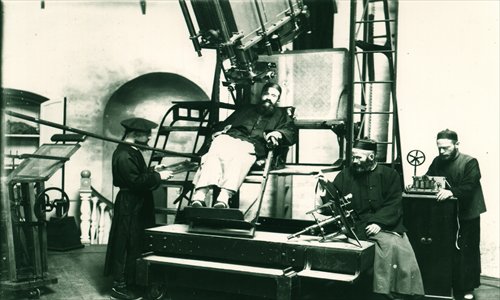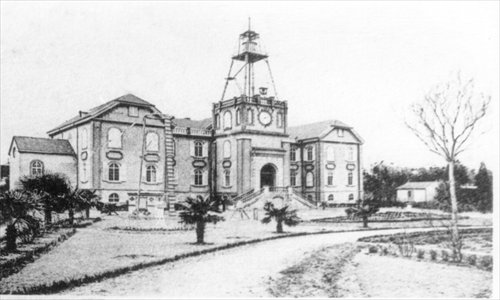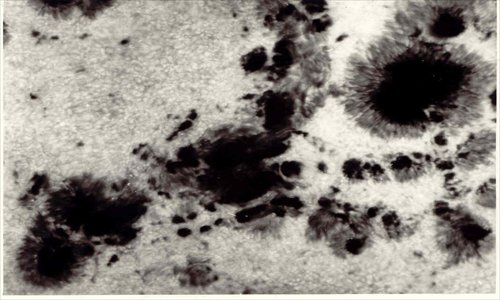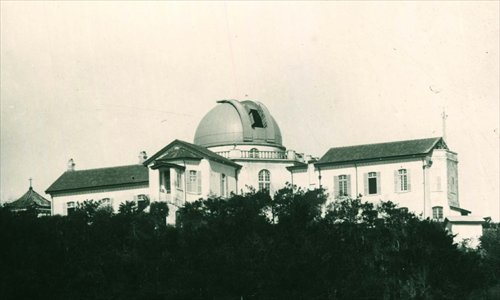Seeing stars

As China's Ming Dynasty (1368-1644) came to its close, Europeans were undergoing a massive rebirth in science and culture. The Renaissance saw Polish mathematician and astronomer Nicolaus Copernicus outline the heliocentric view of the universe, putting the sun, rather than the Earth, at the center and the Italian scientist Galileo improved the telescope and used it to make some major advancements in astronomy.
After the Portuguese first landed at the mouth of the Pearl River in 1513, other Westerners began travelling to China. Among the adventurers and traders were Catholic Jesuit missionaries who came to China to convert the people. But they were more than just preachers. The Jesuits were intellectually rigid and trained scientists who spread Western scientific learning and techniques alongside their religion.
Jesuits like Matteo Ricci, Sabatino de Ursis and Johann Adam Schall von Bell arrived in China and influenced Chinese scholars like the Shanghai-born bureaucrat, scientist and astronomer Xu Guangqi (1562-1633). Xu was influenced by both the science and the religion (he adopted the name Paul as his Christian baptismal name). As a high-ranking official in the Ming Court, Xu used his power and influence to help to spread Catholicism as well as scientific knowledge.
Working with the Jesuits, Xu translated several important Western scientific texts into Chinese, including the classic Euclid's Elements. He was closely involved with astronomy as well and in 1629, Xu used Western astronomical methods to predict a solar eclipse. Chongzhen, the last emperor of the Ming Dynasty, appointed Xu to reform China's calendar.
Rarely changed
Lin Qing is the Director of Science Outreach Office of the Shanghai Astronomical Observatory and explained, "The calendar is closely related to astronomy. Traditionally in China the calendar rarely changed. If the calendar changed people felt there were changes in heaven and Earth."
Lin said that to formulate the Chongzhen Calendar, Xu had to battle traditional attitudes and the thinking of older officials in the Ming Court. Xu wanted to introduce Western astronomical theories and methodology into the Chongzhen Calendar but the die-hards believed that Chinese should follow their ancestors' methods and not adopt new principles from the West. Eventually Xu won the emperor's support.
Xu didn't follow the Copernican theory of planets revolving around the sun, preferring the Tycho Brahe theory that the sun and moon orbited the Earth while the other planets orbit the sun, Lin said.
Sadly Xu died before he could see the completion of the Chongzhen Calendar, which was completed in the December of 1634. Chongzhen himself died before the calendar was officially published and the Ming Dynasty collapsed in 1644.
However the Jesuit astronomer Schall von Bell edited and presented the Chongzhen Calendar to Emperor Shunzhi, the first emperor of the Qing Dynasty (1644-1911). It was used by the Qing Court for several years, although the name was changed to the Shixian Calendar.
Although a Catholic European priest, Matteo Ricci dressed in Chinese clothes and did his best to understand and adapt to Chinese culture. Schall von Bell also had close friendships with emperors. However other missionary orders refused to compromise to Chinese traditions which angered the second emperor of the Qing Dynasty, Kangxi. Missionaries were expelled from China which then underwent a period of isolation until Western gunboats forced it to open up in 1840.

Early days
After Shanghai became one of the nominated trading ports for China, France bought an area of land in today's Xujiahui district, near Xu Guangqi's tomb in the French Concession. In 1872 French Jesuits founded the Xujiahui Observatory there, the first modern observatory in China.
The Shanghai Meteorological Records reported it this way: "In December 1872, the Xujiahui Observatory started meteorological observations. In February 1873, a two-story house was built to the west of Zhaojiabang (Puxi Road today) on the site of the former residence of the Xu family in commemoration of Xu Guangqi's contribution to the spread of Catholicism. In July 1873, the Xujiahui Observatory was established."
Guo Wenhan, an official with the Office of Shanghai Chronicles, the city's records office, explained that most of the work undertaken by the observatory was meteorological observations. Today the Shanghai Astronomical Observatory, the Shanghai Meteorological Service and the Earthquake Administration of Shanghai Municipality are three independent departments but in 19th century Shanghai, all their work was covered by the Xujiahui Observatory.
"Although it was called an observatory, most of the work that the Xujiahui Observatory undertook was not the astronomy that we understand today." Shanghai Astronomical Observatory's Lin prefers to refer to the observatory as a little science academy, a comprehensive center covering a variety of scientific research.

Keeping time
Lin said one of the major tasks for the observatory was providing the precise time, which was vital for ships to navigate. Lin said astronomers could establish the exact time by observing the stars. "This was much more precise than the methods previously used in China like sundials and water clocks because stars were much more exact in their movement."
One of the sidelines of the work of the Xujiahui Observatory can be seen on the Bund today where the stone building, the weather signal tower, still stands. Built in 1884 and rebuilt in 1907, this served as a signal tower where ships could see by the color of the flags being flown, the weather forecasts for the day. And navigators could set chronometers. At 11:45 am every day, a large ball ascended one of the two masts on the tower. At 11.55 am the ball was taken to the top of the mast and at noon precisely the ball dropped giving navigators and passers an exact time.
The information about weather and time came from the Xujiahui Observatory and the midday ritual beside the Huangpu River continued for many years until radio rendered this obsolete. To ensure the accuracy of their work the astronomers used an ornate copper meridian circle imported from Paris in 1925. This can still be seen in the Shanghai Astronomical Museum.
Although the Xujiahui Observatory ran smoothly for several years after its initial establishment, the Jesuit director Stanislas Chevalier wanted to push the observatory into more advanced astronomical work and began fundraising. By 1898 he had collected 100,000 francs which bought a 40-centimeter diameter binocular refracting telescope from Paris, the largest telescope in the Far East in those days.
But when the telescope arrived in Xujiahui, the astronomers discovered that the ground was not stable enough for a telescope of this size to function. The Jesuits then took the telescope to Sheshan, the highest elevation in Shanghai. In 1900, the Sheshan Observatory opened, the first modern observatory in China dedicated to astronomy and research.
Lin said that over the 100 years and more of its existence the observatory telescope at Sheshan had photographed thousands of phenomena, sunspots, clusters, variable stars, comets and asteroids. More than 7,000 of these unique photographs have been preserved. "They are not just historical relics but they also have a scientific value. There are still some scientists using these photographs in their work."

War arrives
When the Japanese invaded Shanghai in 1937 most work at the observatories had to stop. The Shanghai Science and Technology Records reported that the direct telephone line between the Xujiahui and Sheshan observatories was broken. After Germany invaded France in 1940 French government funding for the observatories was halted.
After Shanghai's liberation the two observatories were formally taken over in December 1950 by an administration committee of the new Communist Party government. Then in 1962, the Xujiahui and Sheshan observatories were merged and established as the Shanghai Astronomical Observatory with the Chinese Academy of Sciences. With the Xujiahui Observatory's history of time-keeping Shanghai was given the responsibility of time-keeping for the nation.
In January 1959, Shanghai established China's universal time system. In August 1962, the precision of the time signals was ranked the third highest in the world.
But when it considered security implications, the State Council of China decided to move the responsibility for time from Shanghai into an inland area, and Lintong, a district in Xi'an, Shaanxi Province, was selected. Shanghai sent scientists to help build the Shaanxi Astronomical Observatory there and it is now China's National Time Service Center.
Although one of the observatory's core purposes had been removed, the scientists at the Shanghai Astronomical Observatory continued with a variety of new research programs. After Ye Shuhua became the director in 1981 she introduced three new instruments to their work - a 1.56-meter optical telescope, a 25-meter radio telescope and a 60-centimeter satellite laser ranging system. "The most advanced technology in world astronomy at the time came to Shanghai," noted Lin.
Because of severe light and atmospheric pollution in Shanghai, it has become almost impossible for Shanghai astronomers to carry out visual observations but they now work in fields that do not rely on vision alone. Cosmography and black hole research have become active research fields at the Shanghai Astronomical Observatory and have attracted international recognition.
Today Shanghai also plays an important role in China's lunar exploration program, Chang'e. The key technology that successfully directed the lunar probe along its orbit and then to its soft landing in December is Very Long Baseline Interferometry (VLBI) and, China's VLBI Center is located in the Shanghai Astronomical Observatory. The two radio telescopes in Shanghai work with radio telescopes in Beijing, Kunming, Urumqi together to make up the VLBI network.